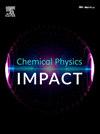平面混合系统中的介电调谐光子-光子耦合
IF 4.3
Q2 CHEMISTRY, PHYSICAL
引用次数: 0
摘要
本文研究了由分裂环谐振器(SRR)和互补分裂环谐振器(CSRR)组成的微波混合系统中的光子-光子耦合(PPC),两者都作为光子模式。利用CST Microwave Studio进行了数值模拟,设计了该系统,并通过检测|S21|与频谱的关系,分析了不同CSRR尺寸下光子模式(SRR和CSRR)之间的防交叉现象。此外,我们提供了一个理论框架来解释由于光子-光子相互作用而观察到的反交叉现象,这与模拟结果非常吻合。通过估算不同εr值下的耦合常数,探讨了衬底介电常数(εr)对PPC的影响。结果表明,耦合强度随εr的增大而减小,为控制混合微波系统中的光子相互作用提供了一个可调参数。这一发现为开发和优化可调系统开辟了新的途径,这对量子技术的进步至关重要。本文章由计算机程序翻译,如有差异,请以英文原文为准。

Dielectric-tuned photon-photon coupling in a planar hybrid system
This study presents photon-photon coupling (PPC) in a microwave hybrid system consisting of a Split Ring Resonator (SRR) and a Complementary Split Ring Resonator (CSRR), both acting as photon modes. Numerical simulations using CST Microwave Studio were performed to design the system and analyze the anticrossing phenomenon between the photon modes (SRR and CSRR) by examining the || versus frequency spectra while varying the size of the CSRR. Additionally, we provide a theoretical framework to explain the observed anticrossing phenomenon due to photon-photon interaction, which shows strong agreement with the simulation. Furthermore, we explore the influence of the substrate's dielectric constant (εr) on the PPC by estimating the coupling constant for different εr values. The results indicate that the coupling strength decreases as εr increases, highlighting a tunable parameter for controlling photon interactions in hybrid microwave systems. This discovery opens new avenues for developing and optimizing tunable systems, which are crucial for progress in quantum technologies.
求助全文
通过发布文献求助,成功后即可免费获取论文全文。
去求助
来源期刊

Chemical Physics Impact
Materials Science-Materials Science (miscellaneous)
CiteScore
2.60
自引率
0.00%
发文量
65
审稿时长
46 days
 求助内容:
求助内容: 应助结果提醒方式:
应助结果提醒方式:


